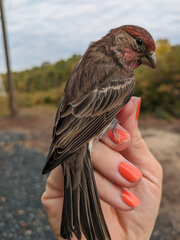Bird ringing
|
|
Bird ringing (also known as bird banding) is an aid to studying wild birds, by attaching a small individually numbered metal or plastic ring to their legs or wings, so that various aspects of the bird's life can be studied by the ability to re-find the same individual later. This can include migration, longevity, mortality, population studies, feeding behaviour, and many other aspects.
| Contents |
Introduction
Birds are either ringed at the nest, or after being trapped in fine mist nets, Heligoland traps, duck decoys or similar.
A ring of suitable size is attached, and has on it a unique number, plus a contact address. The bird is often weighed and measured, and examined for parasites (which may then be removed) before release. The rings are very light-weight, and have no adverse affect on the birds. The individual birds can then be identified when they are re-trapped, or found dead.
The finder can contact the address on the ring, give the unique number, and be told the known history of the bird's movements.
The organising body, by collating many such reports, can then determine patterns of bird movements for large populations.
The first organised schemes for bird ringing were started (in 1909) by Arthur Landsborough Thomson in Aberdeen and Harry Witherby in England, though smaller individual marking tests had began some years earlier in Denmark and Germany.
Similar schemes
Wing tags
In some surveys, involving larger birds such as eagles, brightly-coloured plastic tags are attached to birds' wing feathers. Each has a letter or letters, and the combination of colour and letters uniquely identifies the bird. These can then be read in the field, through binoculars, meaning that there is no need to re-trap the birds. Because the tags are attached to feathers, they drop off when the bird moults. Imping is the practice of replacing a bird's normal feather with a brightly-colored false feather. A patagial tag is a permanent tag held onto the wing by a rivet punched through the patagium.
Radio transmitters and satellite-tracking
Where detailed information is needed on an individuals' movements, scientists can fit tiny radio transmitters to birds. For small species the transmitter is carried as a 'backpack' fitted over the wing bases, and for larger species it may be attached to a tail feather or temporary leg band. Both types usually have a tiny (10cm) flexible aerial to improve signal reception. Two field receivers (reading distance and direction) are needed to establish the bird's position using triangulation. Transmitters may be recovered by recapturing the bird or designed to drop off. The technique is useful for tracing individuals during landscape-level movements particularly in dense vegetation (such as tropical forests) and for shy or difficult-to-spot species, because birds can be located from a distance without visual confirmation. The use of satellite transmitters for bird movements is currently restricted by transmitter size - to species larger than about 400g. They may be attached to migratory birds (geese and swans are popular subjects) or other species undergoing longer-distance flights. Individuals may be tracked by satellites for immense distances, for the lifetime of the transmitter battery. As with wing tags, the transmitters may be designed to drop off when the bird moults; or they may be recovered by recapturing the bird.
Field-readable rings
A field-readable is a ring or rings, usually made from plastic and brightly coloured, which may also have conspicuous markings in the form of letters and/or numbers. They are used by biologists working in the field to identify individual birds without recapture and with a minimum of disturbance to their behaviour. Rings large enough to carry numbers are usually restricted to larger birds, although if necessary small extensions to the rings (leg flags) bearing the identification code allow their use on slightly smaller species. For small species (e.g. most passerines), individuals can be identified by using a combination of small rings of different colours, which are read in a specific order. Most colour-marks of this type are considered temporary (the rings degrade, fade and may be lost or removed by the birds) and individuals are usually also fitted with a permanent metal ring.
Other markers
Head and neck markers are very visible, and may be used in species where the legs are not normally visible (such as ducks and geese). Nasal discs and nasal saddles can be attached to the culmen with a pin looped through the nostrils in birds with perforate nostrils. They should not be used if they obstruct breathing. They should not be used on birds that live in icy climates, as accumulation of ice on a nasal saddle can plug the nostrils. Neck collars made of expandable, non-heat-conducting plastic are very useful for larger birds such as geese.


